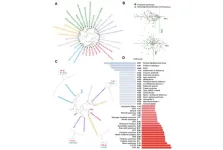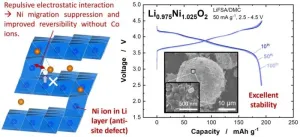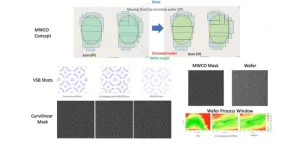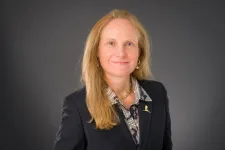(Press-News.org) Fashioned from the same element found in sand and covered by intricate patterns, microchips power smartphones, augment appliances and aid the operation of cars and airplanes. Now, scientists at the U.S. Department of Energy’s (DOE) Princeton Plasma Physics Laboratory (PPPL) are developing computer simulation codes that will outperform current simulation techniques and aid the production of microchips using plasma, the electrically charged state of matter also used in fusion research. These codes could help increase the efficiency of the manufacturing process and potentially stimulate the renaissance of the chip industry in the United States.
“Because devices with microchips are essential to our daily lives, how and where they are made is a matter of national security,” said Igor Kaganovich, a principal research physicist who leads the low-temperature modeling group at PPPL. “Robust and reliable simulation tools that can accurately predict plasma behavior and shorten the manufacturing and design cycle of silicon chips could help the U.S. regain a leadership role in this field and maintain it for decades.”
Picking up the pace
One PPPL research effort involves reducing the time computers need to simulate microchip plasma reactors. This innovation would help private industry use more complex and accurate simulations widely and aid their drive to lower microchip costs. “Companies would like to use simulations to improve their processes, but they typically are computationally expensive,” said Andrew Tasman Powis, co-author of the paper reporting the results in Physics of Plasmas and computational research associate at PPPL. “We are doing our best to counter this trend.”
Physicists usually want simulations to reproduce plasma as accurately as possible, generating virtual pictures that reveal the intricacies of plasma behavior with very fine details. That process requires algorithms, programs following a set of rules, that simulate plasma in very short time increments and in small volumes of space. The catch is that such detailed simulations require powerful computers running for days or weeks at a time. That time frame is too long and too expensive for companies that want to use the simulations to improve their microchip manufacturing processes.
The researchers delved into plasma physics history to find already developed algorithms that might be able to shorten the amount of time necessary to simulate microchip plasma. The researchers found suitable algorithms from the 1980s; when tested, the algorithms demonstrated a capability to model microchip plasma systems in much less time and with only a small reduction in accuracy.
In essence, the researchers found that they could get good simulations even though they were modeling plasma particles within larger spaces and using longer time increments. “This development is important because it could save companies both time and money,” said Haomin Sun, the study’s lead researcher and a former graduate student in Princeton University’s Program in Plasma Physics, based at PPPL. “That means that with the same amount of computational resources, you can create more simulations. More simulations not only allow you to find ways to improve manufacturing, but also to learn more physics in general. We can make more discoveries using our limited resources.”
Related research led by Powis reinforces this possibility. In a paper published in Physics of Plasmas, Powis confirms that computer codes can generate accurate models of plasma particles while using virtual “cells” or small volumes of space that exceed a standard measure in plasma physics known as the Debye length. This development means that the codes can in effect use fewer cells and reduce the need for computing time. “This is good news because reducing the number of cells could lower the computational cost of the simulation and therefore improve performance,” Powis said.
The algorithms can simulate so-called “capacitively coupled plasma reactors,” which create the plasma that engineers use to etch narrow channels in a wafer of silicon. These tiny passageways form the microcircuitry that allows the microchip to function. “We are interested in modeling this process so we can learn how to control the properties of the plasma, predict what they would be like in a new machine, and then predict the etching properties so we can improve the process,” Powis said.
The team plans to test the algorithms further by adding the effects of different kinds of wall and electrode materials. “We want to continue to build confidence in these algorithms so we can be sure the results are accurate,” Powis said.
Recognizing and overcoming inherent limits
Another research effort focuses on errors that can creep into plasma simulations because of the inherent limitations of the simulation methods themselves, which model smaller numbers of plasma particles than are present in real plasma.
“When you simulate plasma, you would ideally like to track every single particle and know where it is at all times,” said Sierra Jubin, graduate student in the Princeton Program in Plasma Physics and lead author of the paper reporting the results in Physics of Plasmas. “But we don’t have infinite computing power, so we can’t do that.”
To get around this difficulty, researchers design code to represent millions of particles as one giant particle. Doing so simplifies the computer’s task, but also amplifies the interactions of the virtual mega-particles. As a result, a change in the proportion of particles moving at one speed versus how many are moving at another — a process known as thermalization — happens more quickly than it does in nature. Essentially, the simulation does not match reality.
“This is a problem because if we don’t address this issue, we won’t be modeling the phenomena as they actually occur in the world,” Jubin said. “And if we want to know how many electrons are moving at a particular speed, generating ions or reactive chemical species that interact with the materials used to make microchips, we won’t be getting an accurate picture.”
To compensate for these computational errors, the researchers found that they could make the mega-particle volumes larger and less dense, muting their interactions and slowing down the changes in particle velocities. “In effect, these results put boundaries on what is possible in microchip plasma simulations, point out constraints that we have to consider, and put forth some solutions,” Jubin said.
Jubin’s findings reinforce the notion that current simulation techniques must be improved. Whether because codes used today require small volume sizes and time increments that together slow simulations or because they produce errors based on computational requirements, scientists need new solutions. “This is actually a paradigm shift in the field,” Kaganovich said, “and PPPL is leading the way.”
This research was supported by PPPL’s laboratory-directed research and development (LDRD) program. Computer calculations were performed at the National Energy Research Scientific Computing Center (NERSC), a DOE user facility located at Lawrence Berkeley National Laboratory, as well as the ANTYA high-powered computing facility at India’s Institute for Plasma Research. The team included researchers from Princeton University, the Swiss Plasma Center at the Ecole Polytechnique Federale de Lausanne, India’s Birla Institute of Technology and Science, India’s Homi Bhabha National Institute, the University of Alberta at Edmonton, Applied Materials, Inc., and China’s Sino-French Institute of Nuclear Engineering and Technology.
***
PPPL is mastering the art of using plasma — the fourth state of matter — to solve some of the world's toughest science and technology challenges. Nestled on Princeton University’s Forrestal Campus in Plainsboro, New Jersey, our research ignites innovation in a range of applications including fusion energy, nanoscale fabrication, quantum materials and devices, and sustainability science. The University manages the Laboratory for the U.S. Department of Energy’s Office of Science, which is the nation’s single largest supporter of basic research in the physical sciences. Feel the heat at https://energy.gov/science and http://www.pppl.gov.
END
Plasma scientists develop computer programs that could reduce the cost of microchips and stimulate American manufacturing
2024-02-21
ELSE PRESS RELEASES FROM THIS DATE:
Novel combination therapy offers promising results for treatment-refractory hepatoblastoma
2024-02-21
Hepatoblastoma (HB) is the most common liver cancer in children. Researchers and physicians in the field are concerned because in the last decade HB has been rising rapidly worldwide and has seen the most rapid increase among all pediatric solid tumors.
A team led by researchers at Baylor College of Medicine has been working on improving therapies for this devastating disease. They recently reported in the Journal of Hepatology a novel treatment strategy that produced encouraging results in animal models.
“High-risk disease leads to high rates of relapse and mortality,” said first author Dr. Andrés F. Espinoza, general ...
New study: Defining the progeria phenome
2024-02-21
“In sum, we have defined what a premature aging disease is and developed tools to allow diagnostics of patients and disease population.”
BUFFALO, NY- February 20, 2024 – A new research paper was published in Aging (listed by MEDLINE/PubMed as "Aging (Albany NY)" and "Aging-US" by Web of Science) Volume 16, Issue 3, entitled, “Defining the progeria phenome.”
Progeroid disorders are a heterogenous group of rare and complex hereditary syndromes presenting with pleiotropic phenotypes associated with normal aging. Due to the ...
Low oxygen in lakes may breathe new life into conservation efforts for water quality
2024-02-21
Abigail Lewis traveled all across the United States for college and graduate school, and she ended up researching lakes in her own hometown.
For one of her graduate research projects, Lewis analyzed 656 lakes across five continents with an international research team. The lakes in her hometown of Waukesha, Wisconsin, were among those included.
“To look back and pull together these two parts of my life has been really satisfying,” said Lewis, who will earn her Ph.D. in biological sciences this spring.
In a paper recently published in Global Change Biology, ...
Engineering a coating for disease-free produce
2024-02-21
Dr. Mustafa Akbulut, professor of chemical engineering, has teamed up with horticultural science professor Luis Cisneros-Zevallos to engineer longer-lasting, bacteria-free produce.
According to Akbulut’s recent publication in Current Research in Food Science, the global fruit and vegetable market loses over 50% of agricultural fruit production during various stages of produce handling and post-harvest treatments.
Many fruits and vegetables already have a layer of food-grade wax that is applied for cosmetic reasons and to prevent water loss. Akbulut’s research combines such wax with nano-encapsulated cinnamon-bark ...
Ochsner Children’s Hospital advocates to close the gap in pediatric heart care
2024-02-21
NEW ORLEANS, LA - Ochsner Children's Hospital, ranked among the top hospitals in the nation for pediatric cardiology and congenital heart surgery, is raising awareness of the need for more pediatric-specific heart devices. As the only pediatric heart transplant program in Louisiana and the only program in the state to offer advanced mechanical support options for pediatric cardiology patients, Ochsner Children’s Hospital is committed to advocating for additional medical devices to enhance its high-quality care to pediatric patients ...
Cobalt-free electrodes achieved with nickel ions
2024-02-20
Many electric vehicles are powered by lithium-ion batteries that rely on cobalt — a scarce, expensive metal with high environmental and social costs. A team of researchers from Japanese and French universities have now developed a practical nickel-based electrode material that opens new avenues to cobalt-free batteries for electric vehicles.
The researchers detailed their findings in a study published on Jan. 15 in the journal Energy Storage Materials.
“There is an undeniable need for cobalt-free, high-energy electrode materials for lithium-ion ...
Throwing lithography a curve
2024-02-20
At the heart of advancing semiconductor chip technology lies a critical challenge: creating smaller, more efficient electronic components. This challenge is particularly evident in the field of lithography, the process used to create intricate patterns on semiconductor materials (called wafers) for the production of chips. Lithography uses a kind of template, called a photomask — or just mask — for creating patterns on semiconductor wafers. The industry is always looking for methods that improve resolution and manufacturability for both masks and ...
St. Jude taps health care start-up veteran as first Senior Vice President of Tech Commercialization
2024-02-20
(MEMPHIS, Tenn., February 20, 2024) St. Jude Children’s Research Hospital has appointed Lisa Jordan, MS, MBA, as the institution’s first-ever Senior Vice President of Technology Commercialization to lead industry partnerships and the commercialization of innovations. Jordan will work with researchers to bring a greater number of new technologies, innovations and scientific breakthroughs to the clinic, enabling breakthroughs from St. Jude laboratories to benefit more patients.
The move, part of the institution’s 2022-2027 ...
Microplastics in every human placenta, new UNM Health Sciences research discovers
2024-02-20
A flurry of recent studies has found that microplastics are present in virtually everything we consume, from bottled water to meat and plant-based food. Now, University of New Mexico Health Sciences researchers have used a new analytical tool to measure the microplastics present in human placentas.
In a study published February 17 in the journal Toxicological Sciences, a team led by Matthew Campen, PhD, Regents’ Professor in the UNM Department of Pharmaceutical Sciences, reported finding microplastics in all 62 of the placenta samples tested, with concentrations ranging from 6.5 to 790 micrograms ...
Examining a century of change in a New York City urban forest
2024-02-20
There haven’t been many long-term studies on urban forests, but data collected from the Thain Family Forest, which the New York Botanical Garden (NYBG) has been stewarding for more than a century, has provided an opportunity for scientists from The Forest School at YSE to study a century of changes of its composition.
Using inventory data from 1937-2021, Eliot Nagele ’21 MF, who initiated the research while a forester at Thain and a student at YSE, documented changes in forest structure, diversity, and composition to assess the health of the forest over time. ...






